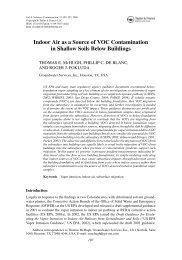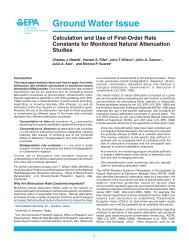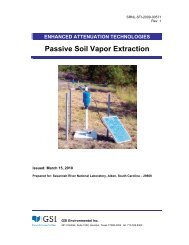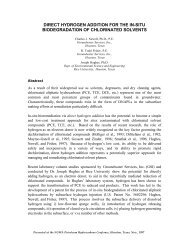Parameter Estimation Guidelines for Risk-Based Corrective Action ...
Parameter Estimation Guidelines for Risk-Based Corrective Action ...
Parameter Estimation Guidelines for Risk-Based Corrective Action ...
You also want an ePaper? Increase the reach of your titles
YUMPU automatically turns print PDFs into web optimized ePapers that Google loves.
TABLE 1. PARAMETER SELECTION GUIDELINES: VOLATILIZATION MODELS<br />
Input <strong>Parameter</strong><br />
Symbol Description Typical Range <strong>Parameter</strong> Measurement or <strong>Estimation</strong> <strong>Guidelines</strong> Reference<br />
SITE-SPECIFIC PARAMETER MEASUREMENTS<br />
W Soil source zone dimension parallel to wind direction Site-specific Measure lateral extent of soil zone serving as source of vapor release (e.g., zone Connor et al, 1995<br />
(cm)<br />
exceeding Tier 1 limits). For on-site POE, use maximum lateral source dimension.<br />
For off-site POE, use dimension measured along line passing from source zone to<br />
nearest downwind off-site POE location.<br />
L GW Depth to groundwater Site-specific For unconfined unit, measure depth to static water level. For confined unit, Connor et al, 1995<br />
measure depth to top of water-bearing stratum.<br />
L s Depth to subsurface soil source (cm) Site-specific Measure depth from ground surface to top of affected source zone. Connor et al, 1995<br />
d or d s Thickness of affected soil zone Site-specific Measure average vertical dimension from top to base of affected soil zone over Connor et al, 1995<br />
lateral area corresponding to W.<br />
h v Thickness of vadose zone (cm) Site-specific Measure from ground surface to depth of static water level in unconfined unit. In<br />
confined unit, measure from ground surface to depth of soil saturation (often<br />
corresponding to potentiometric surface elevation).<br />
Connor et al, 1995<br />
f oc Fraction of organic carbon in soil (g-C/g-soil) 0.001 - 0.03 Conduct lab analyses on representative unaffected soil samples over depth LaGrega, 1994<br />
interval of vertical vapor migration or use generic value of 0.01 <strong>for</strong> vadose zone.<br />
REASONABLE PARAMETER ESTIMATES<br />
U air Windspeed above ground surface in ambient mixing 45 - 450 cm/sec Match to average annual windspeed <strong>for</strong> site area, based on published climatic Connor et al, 1995<br />
zone (cm/s)<br />
data.<br />
δ air Ambient air mixing zone height (cm/s) 200 cm Match to typical height of human breathing zone (6 ft or 2m). Connor et al, 1995<br />
k s Soil-water sorption coefficient (g-H 2 O/g-soil) ----- For organics, estimate as: k s =k oc x f oc . For ionizing organics (e.g.,<br />
U.S. EPA, 1996<br />
chlorophenols), estimate k s based on published pH-dependent partitioning<br />
coefficients <strong>for</strong> ionized and neutral <strong>for</strong>ms.<br />
For inorganics, estimate k s per published pH-dependent isotherms, based on<br />
measured groundwater pH. Detailed guidelines provided in U.S. EPA SSL<br />
Background Document (1996).<br />
ρ s Soil bulk density (g-soil/cm 3 -soil) 1.6 - 1.75 Use median soil value of 1.7 g/cm 3 . ASTM, 1995<br />
Θ T Total soil porosity (cm 3 -pore space/cm 3 -soil) 35 - 55% Estimate based on predominant soil type as follows:<br />
Uni<strong>for</strong>m Sand: 40% Soft Clay: 55%<br />
Mixed-Grain-Sand: 35% Stiff Clay: 37%<br />
Silt: 50%<br />
Θ ws<br />
Volumetric water content in vadose zone soils (cm3-<br />
H 2 O/cm 3 -soil)<br />
13 - 52% Estimate based on predominant soil type as follows:<br />
Uni<strong>for</strong>m Sand: 13% Soft Clay: 52%<br />
Mixed-Grain-Sand: 16% Stiff Clay: 34%<br />
Silt: 42%<br />
NOTE: Typical Θ ws values approximated as saturated water content minus<br />
specific yield of soil.<br />
Peck et al, 1974<br />
Peck et al, 1974<br />
Todd, 1980<br />
Θ as Volumetric air content in vadose zone soils (cm 3 -<br />
3-27% Calculate as Θ as = Θ T - Θ ws , where Θ ws and Θ T estimated per predominant soil Peck et al, 1974<br />
air/cm 3 -soil)<br />
type as above.<br />
Todd, 1980<br />
NOTE: See Equation CM 1 through CM 6 on Figure 2 regarding use of the above parameters <strong>for</strong> estimation of steady-state volatilization factors <strong>for</strong> affected soils. Detailed discussion of<br />
these volatilization models is provided in the Tier 2 RBCA Guidance Manual (see Connor et al, 1995).<br />
continued<br />
NGWA Petroleum Hydrocarbons Conference 13 <strong>Parameter</strong> <strong>Estimation</strong> <strong>Guidelines</strong><br />
Houston, Texas, November 1996<br />
<strong>for</strong> RBCA Modeling






